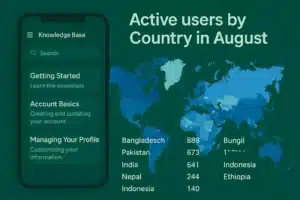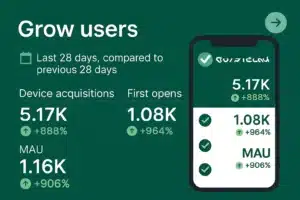In August alone, over 7,300 people used the MyZenCheck AI-powered tongue diagnostic tool to gain insights into their health. But beyond the individual scans lies a deeper narrative—one of global health disparities and growing interest in accessible diagnostics. The data shows that the majority of users came from Bangladesh, Pakistan, and India, indicating high demand in regions where quality healthcare can be limited or delayed.
This article explores what their tongue scans might be telling us, both on a personal and public health level, through the lens of Traditional Chinese Medicine (TCM).
Top 10 Countries by Number of AI tongue diagnostics app Users:
| Rank | Country | Users | 全体の |
|---|---|---|---|
| 1 | Bangladesh | 888 | 23.11% |
| 2 | Pakistan | 673 | 17.52% |
| 3 | India | 641 | 16.68% |
| 4 | Nepal | 244 | 6.35% |
| 5 | Indonesia | 141 | 3.64% |
| 6 | Ethiopia | 140 | 3.67% |
| 7 | United States | 109 | 3.1% |
| 8 | Congo – Kinshasa | 55 | 1.75% |
| 9 | Afghanistan | 43 | 1.59% |
| 10 | Iran | 42 | 1.58% |
Top 10 Countries by Number of AI tongue scan app Users:
“These numbers show not only where people are turning to alternative health insights, but also where quality healthcare is most needed. At the same time, we see growing demand for digital wellness tools, which can bridge the gap between curiosity and care,” said Gabriela Sikorova, Co-founder of MyZenCheck.
Common Tongue Patterns Observed
Although we don’t store personal medical data, aggregated patterns from these regions suggest that the most frequent tongue observations include:
🔹 Pale Tongue
Seen frequently in users from Bangladesh and Nepal, this pattern often indicates Qi or Blood Deficiency, associated with anemia, fatigue, and cold limbs.
Suggested foods: Red dates, beets, liver, millet.
🔸 Red Tongue with Yellow Coating
More prevalent among Pakistan and Indian users, this points to Damp-Heat, potentially linked to poor diet or environmental stress.
Suggested remedies: Bitter teas (dandelion, green tea), cooling foods (cucumber, watermelon).
🟣 Purple Tongue with Swelling
Commonly observed in Ethiopia, indicating blood stagnation or dampness, possibly related to poor circulation or fluid retention.
Supportive herbs: Angelica sinensis, red-root sage, turmeric.
How These Insights Can Drive Global Holistic Strategies
This geographic distribution of tongue types correlates with several real-world health challenges:
- Anemia and nutritional deficiencies: Especially in South Asia, where iron-deficiency anemia remains prevalent.
- Heat-related imbalances: Due to hot climates and spicy diets.
- Metabolic and circulatory issues: In regions where physical activity is low or diets are sugar-heavy.
Our app not only offers early health indicators but also encourages self-care practices rooted in TCM—something that’s both culturally adaptable and cost-effective.
Next Steps for Users in High-Need Regions
- Use Your Tongue as a Daily Health Gauge
Learn what your tongue is telling you and monitor changes regularly. - Apply TCM Recommendations at Home
Many suggestions—like drinking ginger tea or eating red dates—are affordable and easy to implement. - Seek Local Herbal Support
TCM herbs like Rehmannia or Goji berries are becoming more globally available and can support Qi and blood health. - Practice Preventive Wellness
Hydration, rest, and stress reduction play a vital role in tongue health and overall wellness.
結論
At MyZenCheck, we believe empowerment begins with insight. The global use of tongue diagnostics reflects not just curiosity, but a shift toward proactive health management. Whether you’re in Dhaka or Delhi, your tongue can be a mirror of your internal health—and a guide toward balance.
What does a red tongue indicate in TCM?
A red tongue often means internal heat, possibly caused by stress, poor diet, or Yin deficiency.
Is a pale tongue always a sign of anemia?
Not necessarily. While it may indicate Blood Deficiency, it can also reflect Qi or Yang deficiency. A full picture includes other symptoms.
Can tongue diagnosis replace seeing a doctor?
No. It’s a valuable self-awareness tool but should be used alongside professional healthcare advice.
What foods help with a swollen tongue in TCM?
Millet, ginger, and adzuki beans can help reduce dampness. Avoid dairy and cold foods.
How often should I check my tongue?
Once daily in the morning before eating or brushing your teeth is ideal.
Are TCM herbs safe to use without a practitioner?
While many are safe, it’s best to consult a TCM practitioner, especially if you’re on medication or pregnant.
- What Tongue Diagnostics Reveal About Global Health Gaps: Insights from 7,300 Users
- MyZenCheck Team Expands — 10 AI Agents Now Active, Aiming for 25 by Year-End
- MyZenCheck’s AI Tongue Diagnostic App Hits 10,000 Downloads in Just 50 Days
- Evaluation of the MyZenCheck Project After 2 Months: Why We Declined a €500K Offer
- AI Tongue Diagnostics Reaches 5,000 Downloads with a 5-Star Rating on Google Play





